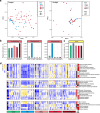The chicken gut metagenome and the modulatory effects of plant-derived benzylisoquinoline alkaloids
- PMID: 30482240
- PMCID: PMC6260706
- DOI: 10.1186/s40168-018-0590-5
The chicken gut metagenome and the modulatory effects of plant-derived benzylisoquinoline alkaloids
Abstract
Background: Sub-therapeutic antibiotics are widely used as growth promoters in the poultry industry; however, the resulting antibiotic resistance threatens public health. A plant-derived growth promoter, Macleaya cordata extract (MCE), with effective ingredients of benzylisoquinoline alkaloids, is a potential alternative to antibiotic growth promoters. Altered intestinal microbiota play important roles in growth promotion, but the underlying mechanism remains unknown.
Results: We generated 1.64 terabases of metagenomic data from 495 chicken intestinal digesta samples and constructed a comprehensive chicken gut microbial gene catalog (9.04 million genes), which is also the first gene catalog of an animal's gut microbiome that covers all intestinal compartments. Then, we identified the distinctive characteristics and temporal changes in the foregut and hindgut microbiota. Next, we assessed the impact of MCE on chickens and gut microbiota. Chickens fed with MCE had improved growth performance, and major microbial changes were confined to the foregut, with the predominant role of Lactobacillus being enhanced, and the amino acids, vitamins, and secondary bile acids biosynthesis pathways being upregulated, but lacked the accumulation of antibiotic-resistance genes. In comparison, treatment with chlortetracycline similarly enriched some biosynthesis pathways of nutrients in the foregut microbiota, but elicited an increase in antibiotic-producing bacteria and antibiotic-resistance genes.
Conclusion: The reference gene catalog of the chicken gut microbiome is an important supplement to animal gut metagenomes. Metagenomic analysis provides insights into the growth-promoting mechanism of MCE, and underscored the importance of utilizing safe and effective growth promoters.
Keywords: Antibiotic; Benzylisoquinoline alkaloid; Chicken; Chlortetracycline; Growth promoter; Gut metagenome; Microbiome.
Conflict of interest statement
Ethics approval
This study was approved by the China Agricultural University Animal Care and Use Committee (CAU 20150428-2).
Consent for publication
Not applicable.
Competing interests
The authors declare that they have no competing interests.
Publisher’s Note
Springer Nature remains neutral with regard to jurisdictional claims in published maps and institutional affiliations.
Figures





Similar articles
-
Metagenome-assembled genomes and gene catalog from the chicken gut microbiome aid in deciphering antibiotic resistomes.Commun Biol. 2021 Nov 18;4(1):1305. doi: 10.1038/s42003-021-02827-2. Commun Biol. 2021. PMID: 34795385 Free PMC article.
-
Metagenome-assembled genome reveals species and functional composition of Jianghan chicken gut microbiota and isolation of Pediococcus acidilactic with probiotic properties.Microbiome. 2024 Feb 12;12(1):25. doi: 10.1186/s40168-023-01745-1. Microbiome. 2024. PMID: 38347598 Free PMC article.
-
Feed-additive probiotics accelerate yet antibiotics delay intestinal microbiota maturation in broiler chicken.Microbiome. 2017 Aug 3;5(1):91. doi: 10.1186/s40168-017-0315-1. Microbiome. 2017. PMID: 28768551 Free PMC article.
-
Bacillus spp. as direct-fed microbial antibiotic alternatives to enhance growth, immunity, and gut health in poultry.Avian Pathol. 2018 Aug;47(4):339-351. doi: 10.1080/03079457.2018.1464117. Epub 2018 May 2. Avian Pathol. 2018. PMID: 29635926 Review.
-
Weight gain by gut microbiota manipulation in productive animals.Microb Pathog. 2017 May;106:162-170. doi: 10.1016/j.micpath.2016.11.002. Epub 2016 Nov 9. Microb Pathog. 2017. PMID: 27836763 Review.
Cited by
-
Mechanism investigation of Forsythoside A against esophageal squamous cell carcinoma in vitro and in vivo.Cancer Biol Ther. 2024 Dec 31;25(1):2380023. doi: 10.1080/15384047.2024.2380023. Epub 2024 Jul 24. Cancer Biol Ther. 2024. PMID: 39046082 Free PMC article.
-
Host specific adaptations of Ligilactobacillus aviarius to poultry.Curr Res Microb Sci. 2023 Sep 11;5:100199. doi: 10.1016/j.crmicr.2023.100199. eCollection 2023. Curr Res Microb Sci. 2023. PMID: 37727231 Free PMC article.
-
Evaluation of dynamic effects of dietary medium-chain monoglycerides on performance, intestinal development and gut microbiota of broilers in large-scale production.Anim Nutr. 2023 May 20;14:269-280. doi: 10.1016/j.aninu.2023.05.003. eCollection 2023 Sep. Anim Nutr. 2023. PMID: 37600838 Free PMC article.
-
PandaGUT provides new insights into bacterial diversity, function, and resistome landscapes with implications for conservation.Microbiome. 2023 Oct 7;11(1):221. doi: 10.1186/s40168-023-01657-0. Microbiome. 2023. PMID: 37805557 Free PMC article.
-
EasyAmplicon: An easy-to-use, open-source, reproducible, and community-based pipeline for amplicon data analysis in microbiome research.Imeta. 2023 Jan 27;2(1):e83. doi: 10.1002/imt2.83. eCollection 2023 Feb. Imeta. 2023. PMID: 38868346 Free PMC article.
References
-
- World Health Organization. Antimicrobial Resistance: Global Report on Surveillance. Geneva: World Health Organization; 2014.
Publication types
MeSH terms
Substances
LinkOut - more resources
Full Text Sources

